Pierce Stocking Scenic Drive | |
|---|---|
Pierce Stocking Scenic Drive highlighted in red | |
| Route information | |
| Maintained by NPS | |
| Length | 7.4 mi[1] (11.9 km) |
| Existed | 1967[2]–present |
| Restrictions | Open to vehicular traffic April–November, 9:00 a.m. to 30 minutes after sunset |
| Points of interest | |
| From | |
| |
| To | |
| Location | |
| Country | United States |
| Counties | Leelanau |
| Highway system | |
The Pierce Stocking Scenic Drive is a scenic route within Sleeping Bear Dunes National Lakeshore, in western Northern Michigan in the United States. The roadway, with its "scenic vistas and gentle curves",[3] is located off state highway M-109 between Empire and Glen Arbor. It runs for 7.4 miles (11.9 km) through forest and dunes areas, providing access to scenic overlooks of the Lake Michigan shoreline and the surrounding park land. Interpretive markers along the roadway are keyed to the National Park Service's printed guide to the drive. Over 80,000 vehicles make the trip, in addition to bicyclists, hikers and skiers who use the road each year.
The road was built in the 1960s and finished in 1967 by Pierce Stocking. A lumberman with road-building experience, he wanted to share the beauty of the area with others. He operated the facility until his death in 1976; afterwards it was purchased by the National Park Service and added to the park. In the 1980s, a two-year program reconstructed the roadway and added a number of features for visiting tourists. In 2011, the morning show Good Morning America named the Sleeping Bear Dunes, and Pierce Stocking Drive, as the "Most Beautiful Place in America" after a viewer poll on its website; publicity since the award has increased traffic along the roadway.
Route description
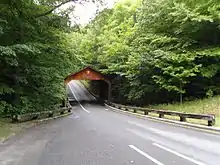
The road is a 7.4-mile (11.9 km) loop that can be driven or bicycled. Hiking the roadway is permitted, but not encouraged because of the traffic.[1] The roadway starts at an entrance off M-109 (DH Day Highway) south of Glen Lake. There is a parking lot inside the entrance for visitors who wish to bike or hike the road. From there, the drive continues as a two-way road to the entrance gate before turning northward as a one-way road. There are 12 numbered locations along the road that are listed in the drive's interpretive brochure. The first of these is a covered bridge. After this point, the drive ascends a steep hill to an overlook of Glen Lake. The area around this location includes "heavily forested areas, sand plains and scrub growth among the rock outcrops".[4] The next stop is the Dune Overlook and Picnic Mountain picnic area. From this vantage point, tourists can view both North and South Manitou islands, also part of the park, as well as Pyramid Point and Sleeping Bear Bay. As the drive approaches this stop and the fourth, the Cottonwood Trail, it emerges from the forest into the sandy dune area next to Lake Michigan. Several more stops are noted in the guide before Pierce Stocking Scenic Drive heads back inland through the beech and maple forest.[2]
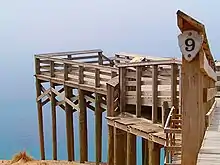
The roadway turns back to the shore and two overlooks next to the lake. Overlook 9 is next to the bluff on Lake Michigan, 450 feet (140 m) above the water, and overlook 10 is for views of the Sleeping Bear Dune. From overlook 9, visitors can see Platte Bay some nine miles (14.5 km) to the south on a clear day.[2][1] These two locations are considered especially hazardous because of the heights involved. In 2002, the Detroit Free Press noted that a half-dozen visitors have to be rescued by paramedics at these two overlooks after falls. The community of Glen Arbor has a special off-road vehicle to effect rescues from the base of the cliffs.[5] The penultimate stop along the drive is the North Bar Overlook and Picnic Area, which provides vistas of North Bar Lake. After this stop, the drive descends into maple and pine forests before coming back to the starting point.[2][1] This area follows an old logging road under the forest canopy.[4] The drive has been called "the best way to see Lake Michigan from top of the dune elevations",[6] and "one of the nation's most fascinating landscapes".[7]
A Park Pass fee is required for using the Pierce Stocking Scenic Drive (except for Golden Age Passport/Senior Pass holders). A free interpretive guide for the scenic drive is available at the visitor center in Empire or at the entrance gate.[8] The road is open to cars generally from the middle of April into November. During the operating season, the road is open starting at 9:00 a.m. until 30 minutes after sunset.[9] After late December, the drive is used as a cross-country ski trail. The park service combines the unplowed roadway with the Shauger Hill Trail to form an eight-mile (13 km) system of trails of various ratings. The speed limit on the Pierce Stocking Scenic Drive is 20 mph (32 km/h).[2] In 2008, there were 82,527 vehicles that circled the drive, a 4.7% increase over the previous year.[10]
History
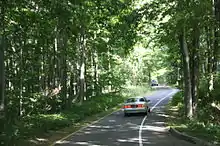
The road is named after Pierce Stocking, who spent his youth working as a Michigan lumberman and used to walk the bluffs above Lake Michigan near Empire. As a lumberman he had experience building roads. Stocking began building a road to the top of the dunes in the difficult terrain around the early 1960s.[2] According to National Geographic, Stocking was "so awed by the beauty of the dunes that ... he built the road in order to share them with visitors."[7] The road was originally known as the Sleeping Bear Dunes Park when he first opened it to the public in 1967. He operated the scenic drive until his death in 1976, charging $2 per car (equivalent to $10.29 in 2022[11]) at the end.[2]
The area around the roadway became part of the Sleeping Bear Dunes National Lakeshore when the park was created in 1970,[3] and the road became part of the park itself in late 1976 when purchased by the park service just before the death of Stocking.[12] The purchase included 2,976 acres (1,204 ha) at a cost of $2.9 million (equivalent to $11.7 million in 2022[13]).[14] It opened to the public without admission fees in June 1977.[12] That first year, 27,252 vehicles used the roadway, an average of 375 per day, but as high as 800 on some Sundays during the 62-day period.[15]
At the time, it was named the Philip A. Hart Nature Trail after the senator, who backed the creation of the national lakeshore. The name proved unpopular with local residents when it was announced.[16] The name was later changed to Pierce Stocking Scenic Drive in honor of the roadway's creator on November 1, 1979.[17]
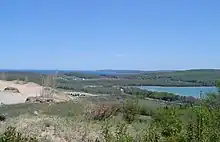
Starting in 1984, the National Park Service reconstructed the drive. It was paved for the first time, and a bicycle lane was added. The service also moved the entrance to the road and built the observation platforms.[2] An original section of the road was closed because it was susceptible to drifting sands from the dunes. Stocking built the covered bridge, but the "NPS has maintained it and increased its vertical clearance to 13 feet 6 inches [4.11 m]."[1] The renovations to the drive were completed in 1986.[1]
In August 2011, the Sleeping Bear Dunes National Lakeshore was named by Good Morning America as the "Most Beautiful Place in America";[18] the designation came after a social media campaign to capitalize on the show's website poll.[19] Since the park was awarded the title, attendance has increased. Pierce Stocking Scenic Drive, featured in the morning show's broadcast, had 0.25-mile-long (0.40 km) lines of cars waiting to get onto the drive on September 3, 2011,[lower-alpha 1] an uncommon sight for a day in September.[20]
Points of interest
The entire roadway is in Glen Arbor Township, Leelanau County.
| mi[21] | km | Number[8] | Point of interest[8] | Notes | |
|---|---|---|---|---|---|
| 0.0 | 0.0 | Entrance to Pierce Stocking Scenic Drive | |||
| 0.4 | 0.64 | — | Entrance gate | Interpretive guides are available here; a park pass is required past this point | |
| 0.7 | 1.1 | Beginning of one-way loop | |||
| 1.1 | 1.8 | 1 | Covered Bridge | Built by Pierce Stocking and renovated by the National Park Service; 13-foot-6-inch (4.11 m) clearance for vehicles | |
| 1.9 | 3.1 | 2 | Glen Lake Overlook | ||
| 2.3 | 3.7 | 3 | Dune Overlook | Bicycle rack available here | |
| 2.4 | 3.9 | 4 | Cottonwood Trail | ||
| 2.5 | 4.0 | 5 | Dune Ecology | Educational station | |
| 2.9 | 4.7 | 6 | Leaving the Sand Dunes | Educational station | |
| 3.0 | 4.8 | 7 | Beech-Maple Forest | Educational station | |
| 4.1 | 6.6 | 8 | Changes over Time | Educational station | |
| 5.1 | 8.2 | 9 | Lake Michigan Overlook | Visitors are cautioned to remain on the walkways for their safety; overlook is 450 feet (140 m) above Lake Michigan | |
| 5.1 | 8.2 | 10 | Sleeping Bear Dune Overlook | Shares a parking lot with the Lake Michigan Overlook; bicycle rack available here | |
| 5.6 | 9.0 | 11 | North Bar Lake Overlook | Bicycle rack available here | |
| 6.1 | 9.8 | 12 | Pine plantation | Educational station | |
| 6.7 | 10.8 | End of one-way loop | |||
| 7.0 | 11.3 | — | Entrance gate | Drop box to return interpretive guides | |
| 7.4 | 11.9 | Exit from Pierce Stocking Scenic Drive | |||
| 1.000 mi = 1.609 km; 1.000 km = 0.621 mi | |||||
See also
- Brockway Mountain Drive, a scenic roadway overlooking Lake Superior near Copper Harbor, Michigan
- River Road National Scenic Byway, a National Scenic Byway and National Forest Scenic Byway in the Huron National Forest
Notes
References
- 1 2 3 4 5 6 Weeks, George (2005). Sleeping Bear: Yesterday & Today (2nd ed.). Ann Arbor: University of Michigan Press. pp. 149–52. ISBN 0-472-03031-0. OCLC 56695949.
- 1 2 3 4 5 6 7 8 DuFresne, Jim (2005). The Complete Guide to Michigan Sand Dunes. Ann Arbor: University of Michigan Press. pp. 109–11. ISBN 0-472-03118-X. OCLC 58599719.
- 1 2 Schmidt, William E. (June 5, 1988). "Michigan: Between the Lake and the Bay, the Leelanau Peninsula". The New York Times. ISSN 0362-4331. OCLC 1645522. Archived from the original on November 17, 2015. Retrieved September 12, 2011.
- 1 2 Nofziger, Fred (July 29, 1984). "Sleeping Bear Dunes: Michigan's Sandy Ice-Age Playground". The Blade. Toledo, Ohio. p. F7. OCLC 12962717. Retrieved September 12, 2011 – via Google News.
- ↑ Ager, Susan (July 9, 2002). "Human Nature Takes Plunge, Pays the Price". Detroit Free Press. p. G1. ISSN 1055-2758. OCLC 10345127, 137343179. Retrieved January 13, 2022 – via Newspapers.com.
- ↑ Phipps, Makena Elizabeth (2004). Foreword. Seasons of Sleeping Bear. By Phipps, Terry W. Ann Arbor: University of Michigan Press. p. 5. ISBN 0-472-11445-X. OCLC 54906225.
- 1 2 National Geographic Society (2001). Guide to Scenic Highways and Byways (2nd ed.). Washington, DC: National Geographic Society. p. 125. ISBN 0-7922-7468-7. OCLC 45648102. Retrieved December 18, 2019 – via Archive.org.
- 1 2 3 National Park Service (n.d.). Pierce Stocking Scenic Drive (Pamphlet). Empire, Michigan: National Park Service.
- ↑ National Park Service (January 5, 2011). "Operating Hours & Seasons". Sleeping Bear Dunes National Lakeshore. National Park Service. Archived from the original on September 3, 2011. Retrieved September 12, 2011.
- ↑ "Numbers at Park Lowest Since '87". The Leelanau Enterprise. Lake Leelanau, Michigan. January 21, 2009. OCLC 35768778. Archived from the original on March 23, 2012. Retrieved September 12, 2011.
- ↑ 1634–1699: McCusker, J. J. (1997). How Much Is That in Real Money? A Historical Price Index for Use as a Deflator of Money Values in the Economy of the United States: Addenda et Corrigenda (PDF). American Antiquarian Society. 1700–1799: McCusker, J. J. (1992). How Much Is That in Real Money? A Historical Price Index for Use as a Deflator of Money Values in the Economy of the United States (PDF). American Antiquarian Society. 1800–present: Federal Reserve Bank of Minneapolis. "Consumer Price Index (estimate) 1800–". Retrieved May 28, 2023.
- 1 2 Charles, Gordon (June 4, 1977). "Sleeping Bear Dune Drive Is Free, Beginning June 19". Traverse City Record-Eagle. p. 17. OCLC 30098364. Retrieved March 4, 2023 – via Newspapers.com.
- ↑ Johnston, Louis; Williamson, Samuel H. (2023). "What Was the U.S. GDP Then?". MeasuringWorth. Retrieved November 30, 2023. United States Gross Domestic Product deflator figures follow the Measuring Worth series.
- ↑ Charles, Gordon (January 19, 1977). "Dunes Lakeshore Phil Hart's Dream". The State Journal. Lansing, Michigan. p. C7. OCLC 9714548. Retrieved March 4, 2023 – via Newspapers.com.
- ↑ Averill, David (September 20, 1977). "Dunes Drive Used Heavily in '77". Traverse City Record-Eagle. p. 4. OCLC 30098364. Retrieved March 4, 2023 – via Newspapers.com.
- ↑ Bowles, Billy (August 21, 1979). "Hart Nature Trail May Lose Name". Detroit Free Press. pp. 1A, 15A. ISSN 1055-2758. OCLC 10345127, 137343179. Retrieved March 4, 2023 – via Newspapers.com.
- ↑ "Ex-Hart Trail". Detroit Free Press. November 2, 1979. p. A3. ISSN 1055-2758. OCLC 10345127, 137343179. Retrieved March 4, 2023 – via Newspapers.com.
- ↑ Orso, Alberto & Parise, Sabrina (August 17, 2011). "Sleeping Bear Dunes Voted 'Most Beautiful Place in America'". Good Morning America. New York: American Broadcasting Company. Archived from the original on August 22, 2011. Retrieved September 12, 2011.
- ↑ Lovy, Howard (August 24, 2011). "The Sleeping Giant Behind Sleeping Bear: How Scenery and Social Media Created 'The Most Beautiful Place in America'". Crain's Detroit Business. Detroit: Crain Communications. ISSN 0882-1992. OCLC 42883891. Archived from the original on September 13, 2012. Retrieved September 12, 2011.
- ↑ Hubbell, Amy & Campbell, Alan (September 8, 2011). "Lakeshore Grows in Popularity". The Leelanau Enterprise. Lake Leelanau, Michigan. OCLC 35768778. Archived from the original on September 12, 2011. Retrieved September 12, 2011.
- ↑ Google (September 19, 2011). "Pierce Stocking Scenic Drive" (Map). Google Earth. Google.
External links
- Pierce Stocking Scenic Drive at Sleeping Bear Dunes National Lakeshore (National Park Service)
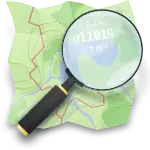 Geographic data related to Pierce Stocking Scenic Drive at OpenStreetMap
Geographic data related to Pierce Stocking Scenic Drive at OpenStreetMap- Video of Overlook 9 on YouTube
